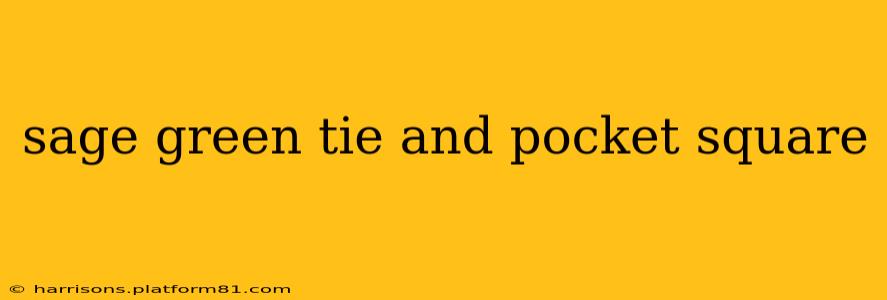Sage green, a muted, sophisticated shade of green, offers a refreshing alternative to bolder tie colors. Its versatility allows it to seamlessly integrate into both formal and semi-formal settings, making it a worthwhile addition to any man's wardrobe. This guide will explore how to best utilize a sage green tie and pocket square, covering everything from coordinating colors and patterns to choosing the right occasion.
What Color Shirt Goes with a Sage Green Tie?
The beauty of a sage green tie lies in its adaptability. Lighter shades like white, light blue, and even a very pale pink create a crisp, clean look ideal for spring and summer events. These pairings offer a refreshing contrast, allowing the subtle green to stand out. For a more autumnal feel, consider pairing your sage green tie with a light beige or cream shirt. This combination evokes a sense of understated elegance. Deeper shades like a light grey or even a very pale lavender can also work well, depending on the specific tone of your sage green tie.
What Color Pocket Square Goes with a Sage Green Tie?
The pocket square is where you can truly personalize your look. A matching sage green pocket square creates a cohesive, sophisticated ensemble, particularly effective for formal occasions. However, don't be afraid to experiment! A white linen pocket square, with its clean and classic appeal, complements sage green beautifully, adding a touch of contrast. For a bolder statement, consider a pocket square in a complementary color such as:
- Light Blue: Provides a refreshing contrast, mirroring the color palette of a light blue shirt.
- Cream or Ivory: Offers a neutral, elegant counterpoint.
- Pale Pink: Creates a surprisingly harmonious and subtly romantic combination.
- Subtle Pattern: A pocket square with a small, understated pattern (such as a paisley or subtle check) in a coordinating color can add visual interest without being overwhelming.
What Occasions Are Suitable for a Sage Green Tie?
Sage green's versatility makes it appropriate for a wide range of occasions:
- Weddings: A sage green tie offers a sophisticated yet not overly formal option for a guest. Pair it with a light-colored shirt and a coordinating pocket square for a refined look.
- Business Meetings: Its muted tone conveys professionalism and subtly distinguishes you from the typical navy or black tie.
- Semi-Formal Events: Sage green works beautifully for events like holiday parties or galas.
- Job Interviews: While not as conventional as navy or black, a sage green tie, particularly with a crisp white shirt, can convey confidence and a touch of individuality.
What Pattern Tie Works Best with Sage Green?
Solid sage green ties are incredibly versatile. However, patterned ties can add personality:
- Small Checks or Stripes: Subtle patterns add texture without being distracting.
- Paisley: A sage green paisley tie can inject a touch of classic elegance, particularly when paired with a plain shirt.
- Floral Patterns: Subtle floral patterns in muted shades can work well for spring or summer occasions. Keep the pattern relatively small and understated for a professional look.
Avoid overly bold or large patterns, as these can clash with the subtle elegance of sage green.
How Do I Choose the Right Fabric for a Sage Green Tie?
The fabric of your tie significantly influences its overall appearance and drape. Consider these options:
- Silk: Offers a luxurious sheen and drape, ideal for formal occasions.
- Wool: Provides a warmer, more textured feel, suitable for cooler months.
- Linen: A lighter, breathable option perfect for warmer weather.
- Cotton: A durable and versatile choice suitable for many occasions.
By carefully considering the shirt, pocket square, and fabric choices, you can confidently incorporate a sage green tie into your wardrobe, adding a touch of understated sophistication to your style. Remember, the key is balance and coordination. Experiment with different combinations to find what best reflects your personal style.
